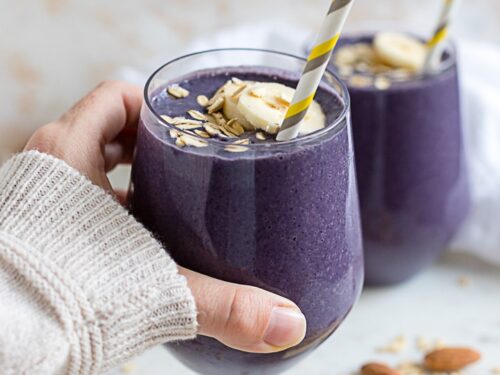If you’ve ever made a smoothie with fresh berries, you know that they can sometimes cause the smoothie to curdle. And while it’s not necessarily harmful to drink a curdled smoothie, it’s not exactly appetizing either. So why does this happen?
There are a few different reasons why blueberries (or any other type of berry) can cause a smoothie to curdle. One reason is that berries are high in acidity. When combined with milk or yogurt (which is also acidic), the acidity can cause the proteins in the milk to coagulate and form clumps.
This is why it’s important to use fresh, ripe berries when making smoothies – overripe berries are even more acidic and are more likely to cause curdling.
What Happens To Your Body When You Eat Blueberries
Your blueberry smoothie curdled because of the high acidity level in the berries. When you blend them, the acidity breaks down the proteins in the milk, causing it to thicken and clump together.
Why Does My Smoothie Curdle
Your smoothie may curdle for a variety of reasons, including using ingredients that are too cold or adding them in the wrong order. Curdling can also occur if your smoothie has been sitting for too long or if it’s been blended for too long. While curdled smoothies aren’t necessarily unsafe to drink, they can be unappetizing.
If you want to avoid a curdled mess, there are a few things you can do.
One reason your smoothie may be curdling is because you’re using ingredients that are too cold. This is especially common when using fresh fruits or vegetables straight from the fridge.
To avoid this, either let your ingredients sit out for a bit before adding them to the blender or use frozen fruits and veggies instead.
Another issue could be the order in which you’re adding your ingredients. When making a smoothie, it’s important to add liquid first, followed by any soft items like bananas or avocados.
Harder items like ice cubes should go in last. If you add your ingredients in the wrong order, they may not blend properly and could cause your smoothie to curdle.
If it’s been more than 30 minutes since you made your smoothie or if you’ve blended it for longer than 2 minutes, chances are good that it will start to curdle. The best way to enjoy a perfectly creamy smoothie is to drink it right away after making it!

Credit: www.nourish-and-fete.com
Why Do My Smoothies Curdle?
If your smoothie has curdled, it’s most likely because the milk or yogurt in your recipe has reacted with the acid in the fruit. This can happen if you let your smoothie sit for too long, or if you use fruits that are particularly high in acid. To avoid curdling, make sure to add milk or yogurt to your smoothie right before you blend it, and use fruits that are low in acidity.
Why Do Blueberries Curdle Milk?
While the exact science is unknown, it is believed that blueberries contain an element that reacts with milk to cause curdling. This reaction is thought to be caused by the tannins in blueberries, which are also found in other fruits and vegetables such as grapes, pears and potatoes. When tannins come into contact with milk, they bind to the milk proteins and cause them to clump together, resulting in a curdled appearance.
While this may not affect the taste of the milk, it can make it appear unappetizing.
Why Did My Blueberry Smoothie Turn into Jello?
If you’ve ever made a smoothie with blueberries, you know that they can be pretty pesky little fruits. They have small seeds that can get stuck in your blender, and they can also turn your smoothie into something resembling jelly if you’re not careful. So, what causes this transformation, and how can you avoid it?
The main reason why blueberries can turn a smoothie into jelly is because of their high pectin content. Pectin is a type of soluble fiber that is found in many fruits and vegetables. When pectin comes into contact with water, it forms a gel-like substance.
This gel-like substance is what gives blueberry jam its characteristic thick texture. While the pectin present in blueberries isn’t necessarily bad for you, too much of it can make your smoothie less than enjoyable to drink. Fortunately, there are a few things that you can do to avoid this problem.
First, make sure to add some liquid to your blender along with the blueberries. This will help to thin out the mixture and prevent the pectin from gelling up too much. Second, consider using frozen blueberries instead of fresh ones.
Frozen berries tend to have less pectin than fresh berries, so they’re less likely to turn your smoothie into jelly. Lastly, don’t overdo it on the blueberries – adding just a handful or two should be enough to give your smoothie flavor without turning it into a gelatinous mess!
Why Do Blueberries Coagulate?
Blueberries coagulate because they are high in pectin. Pectin is a type of soluble fiber that is found in fruits and vegetables. When pectin comes into contact with water, it forms a gel-like substance.
This gel-like substance helps to bind together the blueberries and gives them their firm texture. Blueberries also contain tannins, which are astringent compounds that can also help to coagulate the berries.
Conclusion
Your blueberry smoothie curdled because you used milk that was too old. When milk gets old, it starts to form clumps and those clumps make your smoothie curdle. To avoid this in the future, make sure to use fresh milk or buy milk that has a longer shelf life.
